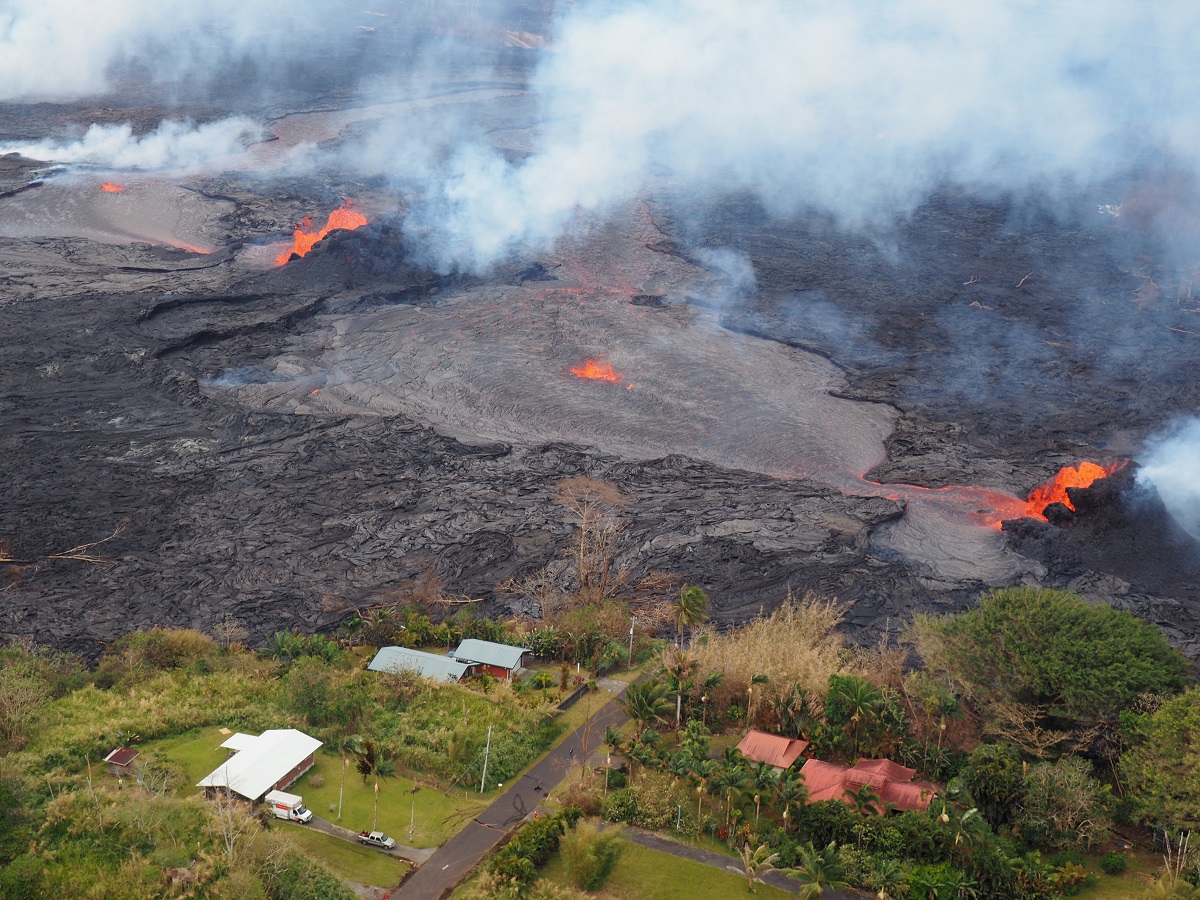From Carnegie Institution for Science (US)
April 07, 2021
The 2018 eruption of Kīlauea Volcano in Hawai‘i provided scientists with an unprecedented opportunity to identify new factors that could help forecast the hazard potential of future eruptions.
The properties of the magma inside a volcano affect how an eruption will play out. In particular, the viscosity of this molten rock is a major factor in influencing how hazardous an eruption could be for nearby communities.

Kilauea. Credit: Diana Roman, Brian Shiro.
Very viscous magmas are linked with more powerful explosions because they can block gas from escaping through vents, allowing pressure to build up inside the volcano’s plumbing system. On the other hand, extrusion of more viscous magma results in slower-moving lava flows.
“But magma viscosity is usually only quantified well after an eruption, not in advance,” explained Carnegie’s Diana Roman. “So, we are always trying to identify early indications of magma viscosity that could help forecast a volcano’s eruption style.”
She led new work identifying an indicator of magma viscosity that can be measured before an eruption. This could help scientists and emergency managers understand possible patterns of future eruptions. The findings are published in Nature.
The 2018 event included the first eruptive activity in Kīlauea’s lower East Rift Zone since 1960. The first of 24 fissures opened in early May, and the eruption continued for exactly three months. This situation provided unprecedented access to information for many researchers, including Roman and her colleagues—Arianna Soldati and Don Dingwell of Ludwig Maximilians University of Munich [Ludwig-Maximilians-Universität München](DE), Bruce Houghton of University of Hawai‘i at Mānoa (US), and Brian Shiro of the U.S. Geological Survey’s Hawaiian Volcano Observatory.
The event provided a wealth of simultaneous data about the behavior of both high- and low-viscosity magma, as well as about the pre-eruption stresses in the solid rock underlying Kīlauea.
Tectonic and volcanic activity causes fractures, called faults, to form in the rock that makes up the Earth’s crust. When geologic stresses cause these faults to move against each other, geoscientists measure the 3-D orientation and movement of the faults using seismic instruments.

A fast-moving lava channel flowed from the Ahu’aila’au cone about 10 kilometers away to the ocean, where it covered about 36 square kilometers of land along the way and created 3.5-square-kilometers of new land along the coast. Where the channel slowed down in flat areas, it spread out and formed a braided pattern, seen here. Credit: B. Shiro/USGS.
By studying what happened in Kīlauea’s lower East Rift Zone in 2018, Roman and her colleagues determined that the direction of the fault movements in the lower East Rift Zone before and during the volcanic eruption could be used to estimate the viscosity of rising magma during periods of precursory unrest.

Lava fountaining from the most productive eruptive fissure, called fissure 8 at the time and now named Ahu’aila’au, built a cinder cone 55 meters high, about the height of a 10-story building. Most of the 2018 lower East Rift Zone eruption’s 0.8 cubic kilometers of lava erupted from this point. Credit: B. Shiro/USGS.
“We were able to show that with robust monitoring we can relate pressure and stress in a volcano’s plumbing system to the underground movement of more viscous magma,” Roman explained. “This will enable monitoring experts to better anticipate the eruption behavior of volcanoes like Kīlauea and to tailor response strategies in advance.”
See the full article here .

five-ways-keep-your-child-safe-school-shootings
Please help promote STEM in your local schools.
Carnegie Institution for Science (US)
Andrew Carnegie established a unique organization dedicated to scientific discovery “to encourage in the broadest and most liberal manner investigation; research; and discovery and the application of knowledge to the improvement of mankind…” The philosophy was and is to devote the institution’s resources to “exceptional” individuals so that they can explore the most intriguing scientific questions in an atmosphere of complete freedom. Carnegie and his trustees realized that flexibility and freedom were essential to the institution’s success and that tradition is the foundation of the institution today as it supports research in the Earth, space, and life sciences.
The Carnegie Institution of Washington (US) (the organization’s legal name), known also for public purposes as the Carnegie Institution for Science (US) (CIS), is an organization in the United States established to fund and perform scientific research. The institution is headquartered in Washington, D.C. As of June 30, 2020, the Institution’s endowment was valued at $926.9 million. In 2018 the expenses for scientific programs and administration were $96.6 million.
History
When the United States joined World War II Vannevar Bush was president of the Carnegie Institution. Several months before on June 12, 1940 Bush had been instrumental in persuading President Franklin Roosevelt to create the National Defense Research Committee (later superseded by the Office of Scientific Research and Development) to mobilize and coordinate the nation’s scientific war effort. Bush housed the new agency in the Carnegie Institution’s administrative headquarters at 16th and P Streets, NW, in Washington, DC, converting its rotunda and auditorium into office cubicles. From this location Bush supervised, among many other projects the Manhattan Project. Carnegie scientists cooperated with the development of the proximity fuze and mass production of penicillin.
Research
Carnegie scientists continue to be involved with scientific discovery. Composed of six scientific departments on the East and West Coasts the Carnegie Institution for Science is involved presently with six main topics: Astronomy at the Department of Terrestrial Magnetism (Washington, D.C.) and the Observatories of the Carnegie Institution of Washington (Pasadena, CA and Las Campanas, Chile); Earth and planetary science also at the Department of Terrestrial Magnetism and the Geophysical Laboratory (Washington, D.C.); Global Ecology at the Department of Global Ecology (Stanford, CA); Genetics and developmental biology at the Department of Embryology (Baltimore, MD); Matter at extreme states also at the Geophysical Laboratory; and Plant science at the Department of Plant Biology (Stanford, CA).







